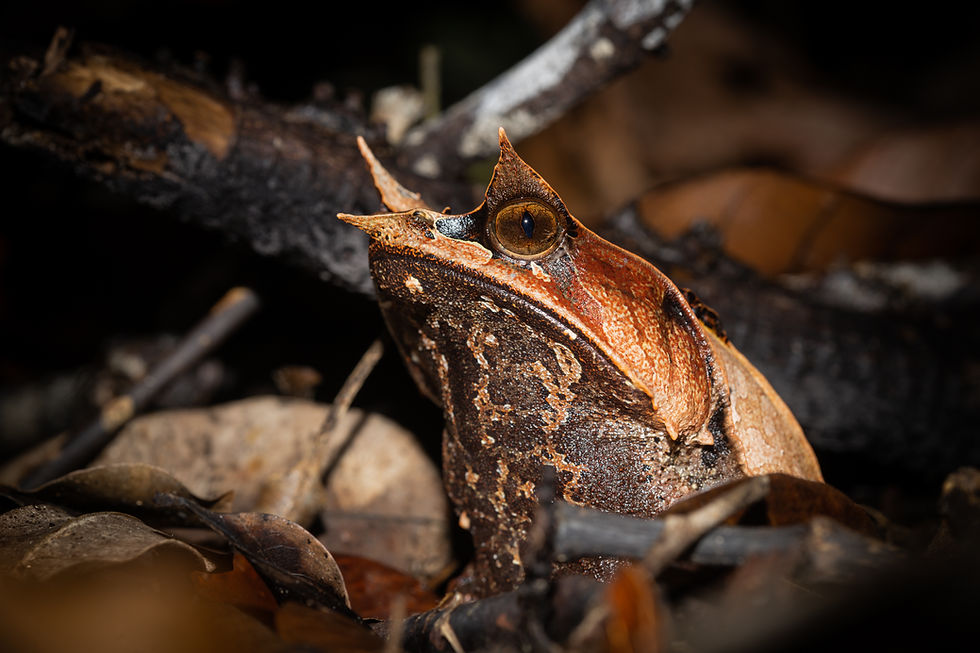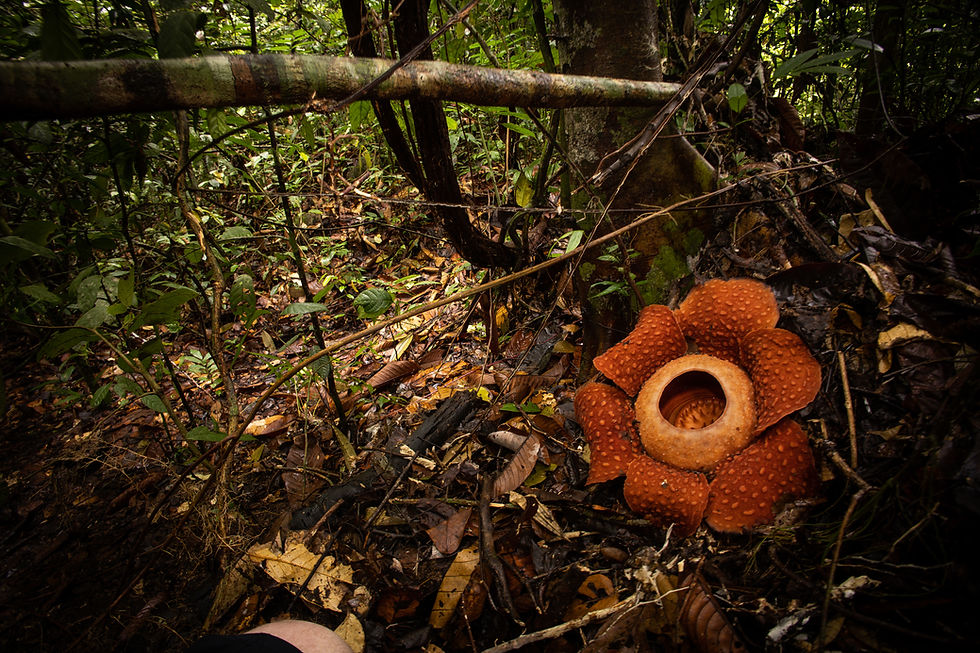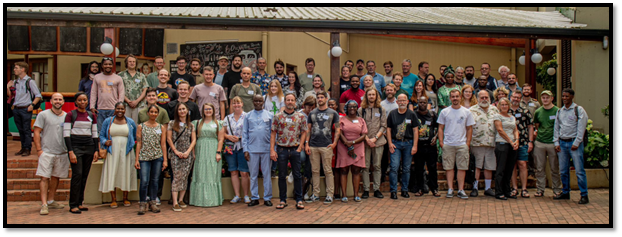The Croak #6 - Frogs, Mountains and Films
- Dr Jeanne Tarrant

- May 10
- 6 min read
Updated: Oct 25
The Power of Connecting
Over the last year, our team has had the privilege of attending and participating in several networking opportunities and conferences. Post-covid and generally spending a lot of time working from home, it still feels quite special to be able to connect in person with colleagues, friends, and have the opportunity to make new acquaintances. From Malaysian rainforests to the southern Cape, to the majestic Drakensberg, we’ve been fortunate to attend an array of events, always with the goal of learning from others, and putting our frog mark on the map!

In August 2024 we travelled east to the island nation of Borneo for the 10th World Congress of Herpetology. This is the pinnacle of congresses as far as herpetology goes, taking place every four years. Last year’s WCH brought together over 1400 delegates from 70 countries across the globe. With over 15 parallel sessions, hundreds of talks, partner lunch and dinner meetings, special sessions and inspiring plenaries, we had a full agenda. We connected with colleagues from the Amphibian Survival Alliance, Amphibian Specialist Group, Synchronicity Earth, Herp Cameroon, Herp Ghana, Herp Conservation Ghana, Save the Frogs Ghana, Zoological Society of London, and many more.
A key outcome of this gathering was a strong desire for African herpetologists to build a stronger network between the few organisations working in amphibian and reptile on the continent, including Madagascar. For the first time we got to meet Caleb Oferi Boateng who runs Herp Conservation Ghana, one of just a handful of non-profit organizations working on the African continent dedicated to amphibian conservation. We also met with Marina Kameni (Herp Cameroon), Sandra Owusu-Gyamfi (Save the Frogs Ghana) and Angelica Crottini (Amphibian Specialist Group regional chair for Madagascar. Several task forces and networks in now underway as a result of WCH.

Of course, we also couldn’t travel so far without appreciating the local wildlife. Borneo is the 3rd largest tropical island in the world, and home to the oldest and most diverse equatorial rainforests. The herpetofauna is fascinating, with over 200 species of anurans (frogs) and over 300 reptile species, most of which are endemic. You can imagine the joy of being able to see some of these first hand. With the many herpetologists visiting, the specialist herp tours were fully booked all week! We were fortunate to participate in a guided frogging tour at Kubah National Park, as well as spend time in Guning Gading where we saw many species of frog, snake and lizards, as well as the rare opportunity to see a flowering Rafflesia, the world’s largest flower that only open for a few days in their lifetime.

Next on the conference calendar was the Herpetological Association of Africa conference, held in Wilderness, Western Cape, South Africa in November 2024. This was the 16th gathering of this meeting, and for the first time was combined with the African Amphibian Working Group meeting, which we assisted in organising as part of the HAA conference committee. Much gratitude to HAA for allowing AAWG to be part of proceedings. The combination worked well and attracted many more delegates to the AAWG component than it normally would.

Our keynote for the opening AAWG address was by David Blackburn, who spoke about phylogenetics of Central African Night frogs. Day 2 saw a fantastic recount from Angelica Crottini on evolution and conservation of the amphibians of Madagascar, which now hosts an astounding 432 frog species, 99% of which are endemic. Once again it was marvellous to connect in person with our herpetological colleagues from South Africa, and importantly with more African attendees than have previously participated. With support from Synchronicity Earth and the Carl Gans Foundation in particular, delegates from nine African countries were able to attend, further strengthening the willingness to grow a better African network of herpetologists.

March 2025 found us closer to home in KwaZulu-Natal, both in the Berg and at the coast for two completely different events, but both connected to nature. First, we were invited to attend and present at a special session on biodiversity at the 2nd South African Mountain Conference in the central Berg. Here over 300 scientists, conservation practitioners, community representatives and even Lesotho royalty spent five days sharing learnings and lessons on all things montane. Large extents of southern Africa, an indeed the world, are covered in mountains, the fauna and flora of which have supreme adaptations to high elevations, extreme temps and increasing human impact. Our special session was part of a global initiative to assess montane biodiversity – the Global Mountain Biodiversity Assessment (GMBA).
The session was aimed at convening biodiversity scientists interested in an assessment of the status of and trends in African mountain species and in African mountain biodiversity research, with the specific objectives to (1) bring together African mountain biodiversity specialists and map existing expertise onto taxonomic groups and mountain systems, (2) share examples of ongoing African mountain species accounts and assessments, and (3) identify research questions and hypotheses as well as policy needs underlying an African synthesis of mountain biodiversity knowledge and trends. Finally, the session at SAMC created the opportunity establish a regional GMBA hub for Africa.
Many of South Africa’s frogs are associated with mountains, in fact, almost all species’ ranges overlap in some way with areas defined as montane by the GMBA. Our talk highlighted some of the unique adaptations of frogs to surviving these extreme conditions. For example, the umbraculum of the Maluti River Frog, Amietia vertebralis, protects the eye of the frog from the high UV levels experienced in Lesotho, where this species occurs.

Of course, we also gave a lot of airtime to our flagship favourite, the Long-toed Tree Frog, Leptopelis xenodactylus, which is an Endangered species that occurs across the foothills of the southern Drakensberg and KwaZulu-Natal Midlands. It is restricted to hummocky, dolomitic wetlands on the slopes of the foothills. While a member of the Tree frog genus, no trees naturally occur within the grassland biome where this species is found. The species has evolved really long-toes to help it climb up grass stalks, from which males issue their ‘baby crocodile’ calls. The conference was a great opportunity to reconnect not only with zoologists, but botanists, social biologists and representatives from across the world. Opportunities stemming from this meeting have included exploration of amphibian projects in Lesotho and the northern Drakensberg, as well as Eswatini.

At the end of March, we were invited to attend the NEWF Congress – Nature Environment Wildlife Film, which has been running for 8 years and brings together aspiring filmmakers, cinematographers, photographers, conservationists and scientists to tell the story of African wildlife, by Africans themselves, with an African score as the background music. Supported by National Geographic, the NEWF initiative ‘Africa Refocused’ has seen an incredible 340 NEWF Fellows being able to tell their story. The theme of mentorship is powerful throughout the Congress, and it is wonderful to see the willingness of industry greats sharing insights and pro-tips. Powerful imagery, real conversations and true inclusiveness creates a strong platform for storytelling. Without storytelling, our conservation work cannot thrive or be understood. We are excited to explore opportunities through this refound connection with NEWF and are looking forward to bringing frogs to the fore through NEWF’s internship programme in Zululand.
The value of attending meetings such as these cannot be underestimated. Firstly, it is wonderful to connect with so many familiar faces, as well as connect with new faces that we’ve only interacted with online but have not yet had the opportunity to meet in person. Aside from the incredible networking value, the benefits of attending symposia with conservation and research presentations allow us to learn from the global community and engage with people outside of our immediate network. By learning how methodologies are being implemented and connecting directly with the people doing this, broadens our horizons from what is happening in South Africa. Another benefit is the realisation that we share many of the same challenges with our colleagues from the global south (and in fact in the developed world too) and a key outcome is to think more collectively how we go about trying to address these.
For the next few months we look forward to consolidating new connections, building on existing ones and strengthening the African amphibian conservation network.







Comments